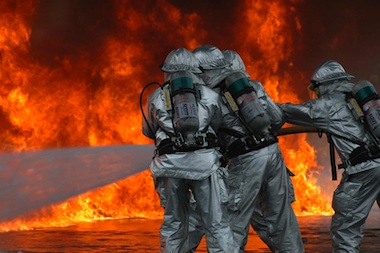
Local governments’ emergency response capabilities have been tested during many difficult situations, including wildfires, tornadoes, flooding, hurricanes, foreign and domestic terror attacks, and many others. Managing and protecting citizens during and after these incidents takes an enormous amount of planning and coordination.
Common challenges faced by local governments include the budgetary restraints caused by the reduction of available FEMA grant funding along with the decline of state aid to the local level. Budgetary issues challenge local governments to do more with less in managing complex communication requirements.
This article focuses on emergency communications by sharing best practices to aid local governments in evaluating current communications plans and future planning.
First Responders
The United States has a highly trained first-responder community. However, first responders—emergency medical services (EMS), fire-rescue personnel, and law enforcement officers—need to have reliable voice communications and the ability to share vital data information across disciplines and jurisdictions to successfully respond to day-to-day incidents and large-scale emergencies.
The general assumption by the public and by insiders is that emergency response agencies across the nation are already interoperable. In actuality, emergency responders often cannot talk to some parts of their own agencies, let alone communicate with agencies in neighboring cities, counties or states.
Public safety advocacy agencies working with first responders and congressional leadership have made progress in developing a plan and securing funding to deploy a nationwide interoperable network. However, the deployment schedule for that network is still undecided. Local governments must still work closely with surrounding communities to ensure interoperability.
To address current communication needs, local agencies will need to rely on a hybrid approach of leveraging both commercial and private networks by utilizing landline, wireless, and potentially satellite communications. Communication systems your organization currently utilizes may include the following components:
- Traditional landline telephone service
- Private branch exchange (PBX)
- Voice-over-IP (VoIP)
- Land mobile radios (LMR) and network infrastructure
- Wireless cell phones, smartphones, tablets, and modems
- Interoperability gateways
- Various types of data or Internet circuits.
In addition, a trend is emerging toward utilizing applications that provide real-time actionable intelligence and provide a common operating picture. Some of these applications may include:
- Computer aided dispatch (CAD)
- Automated vehicle location (AVL) and global positioning systems (GPS)
- Video surveillance
- Special purpose HazMat or emergency management software.
To ensure effective management of any crisis, both voice and data networks and applications need to be resilient, secure, and accessible.
When looking to leverage commercial or private networks, applications, or solutions, there are several critical questions to investigate:
- Is the network or data center resilient to power loss?
- Is the cell site infrastructure robust enough to survive common weather events in the region’s geography? Is there redundancy in the system?
- What system assets are available to restore service if and when there is an outage? What are the rules around deploying them and what are the costs?
- Does the application or network have any single points of failure?
Local Government Assets
Municipal and county governments’ disaster recovery plans typical include the following critical assets:
- Emergency operation center
- City or town hall, county buildings
- Police, fire, and EMS headquarters
- Schools
- Recreational and public health facilities
- Public works buildings and vehicles
- City, county, and school vehicles.
These assets may be used for command and control, data centers, personnel staging, evacuation, emergency storage, and many other critical functions. These assets are critical components of any disaster plan – and require redundant communications.
Addressing the Need – Some Recommendations
First and foremost, municipalities must carefully assess communication infrastructure and emergency plans. Disaster recovery starts with emergency planning.
- Evaluate commercial partners to ensure the networks and applications meet sustainability requirements. If not, change vendors as needed and incorporate them in the planning process.
- For planning sessions, including existing commercial partners can benefit a local government. Sharing best practices and new technologies will enhance the preparedness plan.
- A strategy to execute and deploy regular emergency exercises to test the infrastructure and incident management coordination is essential.
Save the date! ICMA and Verizon will be presenting a webconference on Thursday, May 3. Registration details will soon be provided.
New, Reduced Membership Dues
A new, reduced dues rate is available for CAOs/ACAOs, along with additional discounts for those in smaller communities, has been implemented. Learn more and be sure to join or renew today!
